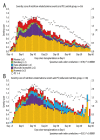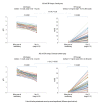Benefit of Reducing Body Weight Loss with A Nutritional Support Pathway in Patients Undergoing Allogeneic Hematopoietic Stem Cell Transplantation
- PMID: 31503241
- PMCID: PMC6754707
- DOI: 10.12659/MSMBR.917329
Benefit of Reducing Body Weight Loss with A Nutritional Support Pathway in Patients Undergoing Allogeneic Hematopoietic Stem Cell Transplantation
Abstract
Background: This retrospective, historically controlled investigative study examined the benefit of a nutritional support pathway that included nutritional education before the start of conditioning and emphasized oral nutrition in response to nutrition-related adverse events in patients undergoing hematopoietic stem cell transplantation (HSCT).
Material and methods: Participants were patients undergoing allogeneic HSCT; 46 were in the control group (i.e., did not follow our nutritional pathway) and 36 were in the group that underwent nutritional intervention (enhanced nutrition group). We compared the following parameters between groups from the day before the start of conditioning to the day after completion of parenteral nutrition (PN): percent loss of body weight (%LBW), percent loss of skeletal muscle mass (%LSMM), and estimated basal energy expenditure (EBEE) sufficiency rate. The relationship between each parameter and %LBW was also examined. We also compared nutritional indices, gastrointestinal graft versus host disease (GvHD) grade, oral energy intake, and %LBW between groups.
Results: There was a relationship between %LBW, %LSMM, and EBEE sufficiency rate in both groups. Compared with the control group, the enhanced nutrition group had significantly improved energy intake amount, EBEE sufficiency rate, PN duration, and oral energy intake over time. The enhanced nutrition group also had increased oral energy intake, no difference in gastrointestinal GvHD grade, and improved %LBW compared with the control group.
Conclusions: Use of our nutritional support pathway in patients undergoing HSCT may be beneficial for %LBW and gastrointestinal GvHD grade, enabling early enhanced nutritional intervention after HSCT.
Figures





Similar articles
-
Nutritional risk in allogeneic stem cell transplantation: rationale for a tailored nutritional pathway.Ann Hematol. 2017 Apr;96(4):617-625. doi: 10.1007/s00277-016-2910-9. Epub 2017 Jan 3. Ann Hematol. 2017. PMID: 28050676
-
A multi-center, randomized, controlled trial of parenteral nutrition titrated to resting energy expenditure in children undergoing hematopoietic stem cell transplantation ("PNTREE"): rationale and design.Contemp Clin Trials. 2010 Mar;31(2):157-64. doi: 10.1016/j.cct.2009.12.002. Epub 2010 Jan 3. Contemp Clin Trials. 2010. PMID: 20004739 Free PMC article. Clinical Trial.
-
Nutritional aspects in allogeneic hematopoietic stem cell transplantation in children and adolescents in a tertiary hospital.Nutr Hosp. 2019 Mar 7;36(1):20-24. doi: 10.20960/nh.2050. Nutr Hosp. 2019. PMID: 30816791 English.
-
Enteral versus Parenteral Nutrition as Nutritional Support after Allogeneic Hematopoietic Stem Cell Transplantation: a Systematic Review and Meta-Analysis.Transplant Cell Ther. 2021 Feb;27(2):180.e1-180.e8. doi: 10.1016/j.jtct.2020.11.006. Epub 2020 Dec 13. Transplant Cell Ther. 2021. PMID: 33830034
-
Systematic Nutritional Support in Allogeneic Hematopoietic Stem Cell Transplant Recipients.Biol Blood Marrow Transplant. 2015 Oct;21(10):1707-13. doi: 10.1016/j.bbmt.2015.07.003. Epub 2015 Jul 11. Biol Blood Marrow Transplant. 2015. PMID: 26172477 Review.
Cited by
-
Examination of a nutritional treatment pathway according to pretreatment health status and stress levels of patients undergoing hematopoietic stem cell transplantation.PLoS One. 2022 Aug 1;17(8):e0271728. doi: 10.1371/journal.pone.0271728. eCollection 2022. PLoS One. 2022. PMID: 35913908 Free PMC article.
-
Weight loss post-allogeneic stem cell transplant is associated with increased transplant-related mortality.Support Care Cancer. 2023 Sep 7;31(10):564. doi: 10.1007/s00520-023-08022-9. Support Care Cancer. 2023. PMID: 37676349
-
Examining the Benefits of Digitally Selectable Meals Called "À La Carte Digital-Select" in Cancer Chemotherapy Patients.Nutr Metab Insights. 2022 May 17;15:11786388221098507. doi: 10.1177/11786388221098507. eCollection 2022. Nutr Metab Insights. 2022. PMID: 35601408 Free PMC article.
-
Examining the Beneficial Aspects of Nutritional Guidance Using Estimated Daily Salt Intake in Cancer Patients with Ischemic Heart Disease.Med Sci Monit Basic Res. 2021 Jan 19;27:e927719. doi: 10.12659/MSMBR.927719. Med Sci Monit Basic Res. 2021. PMID: 33462172 Free PMC article.
-
Nutritional Prehabilitation Intervention in Hematological Patients Undergoing Bone Marrow Transplant: A Systematic Review of the Literature.Nutrients. 2024 Dec 20;16(24):4387. doi: 10.3390/nu16244387. Nutrients. 2024. PMID: 39771008 Free PMC article.
References
-
- Deeg HJ, Seidel K, Bruemmer B, et al. Impact of patient weight on non-relapse mortality after marrow transplantation. Bone Marrow Transplant. 1995;15:461–68. - PubMed
-
- Dickson TM, Kusnierz-Glaz CR, Blume KG, et al. Impact of admission body weight and chemotherapy dose adjustment on the outcome of autologous bone marrow transplantation. Biol Blood Marrow Transplant. 1995;5:299–305. - PubMed
-
- Aoyama T, Imataki O, Mori K, et al. Nutritional risk in allogeneic stem cell transplantation: Rationale for a tailored nutritional pathway. Ann Hematol. 2017;96:617–25. - PubMed
-
- Aoyama T, Arai H, Imataki O, et al. Factors influencing loss of body weight in cord blood transplantation with nutritional support for hematopoietic stem cell transplantation. Asian Journal of Clinical Nutrition. 2017;9:137–46.
-
- Mousavi M, Hayatshahi A, Sarayani A, et al. Impact of clinical pharmacist-based parenteral nutrition service for bone marrow transplantation patients: A randomized clinical trial. Support Care Cancer. 2013;21:3441–48. - PubMed

